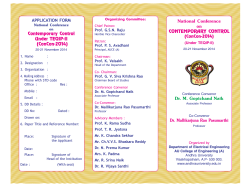
Document
Assistant Professor: Zhou Yufeng N3.2-01-25, 6790-4482, yfzhou@ntu.edu.sg http://www3.ntu.edu.sg/home/yfzhou/courses.html 1. Two blocks A and B, of mass 12 kg and 15 kg, respectively, hang from a cable that passes over a pulley of negligible mass. The blocks are released from rest in the position shown and block B is observed to strike the ground with a velocity 1.4 m/s. Determine (a) the force exerted by the cable on each of the two blocks, (b) the work done by the friction torque during the interval. (a) For Particle A 1 1 2 TA mA g s 2 mA v TA 12 g15. 2 (12)14. 2 TA=125.56 (N) For Particle B 1 1 2 15 g T 1 . 5 (15)1.4 2 TB= 137.35 (N) mB g TB s 2 mB v B 2 (b) For the massless pulley (TB TA)s | Mf | = 0 | Mf |= 17.685 (Nm) Note: the work done by the friction torque should be negative. Alternatively, we may consider System = A + pulley + B 2. The coefficients of friction between the load and the flatbed trailer shown are s =0.4 and k =0.35. Knowing that the speed of the rig is 90 km/h, determine the shortest time in which the rig can be brought to a stop if the load is not to shift. Knowing that the trailer and the load A are moving together: v1 90iˆ(km / h) 25iˆ(m / s), v2 0 Consider the load A F f s ( mA g )i Using Principle of Impulse and Linear Momentum I12 L2 L1 F f t mA v 2 mA v1 ( m g ) t i m v s A A 1 t 25 6.371( s) 0.4 g 3. The 50-N block is original at rest on the smooth surface. It is acted upon by a radial force of 10 N and a horizontal force of 35 N, always directed at 30 from the tangent to the path as shown. Determine the time required to break the cord, which requires a tension T = 150 N. What is the speed of the block when this occurs? Neglect the size of the block for the calculation. Considering all the forces acting on B at the moment when the cord is broken (at position 2), and using Newton’s second law in normal direction, we have F n man m22 r 2 4.4753(rad / s) v 5.37(m / s) Applying Principle of Angular Impulse and Momentum, The moment of the inertia of the particle about O is 50 I O mr 2 1.22 7.3394(kgm2 ) g ( ang) I12 H O 2 H O1 M O t I O2 0 35 cos 30(1.2)t 7.3394(4.4753) t 0.903 P2.17 A rod AB of length 600 mm is pinned at B on a disk of radius r = 200 mm. End A is pin joined to a bar OA, which is of length 600 mm and connected to a fixed pivot at O. The disk rolls without slipping on the ground. At the position shown, point G has a speed of v = 100 mm/s to the right and zero acceleration. Determine angular velocity and angular acceleration of bar OA at the position shown. vB v A vB / A BA 0, vB vA vB 150iˆ AO v A AO rAO AO rAO iˆ vA vB 0.25rad / s rAO rAO aB a A aB / A n (150 100) 2 ˆ aB aB j 25 ˆj 100 2 n vA ˆ 150 2 ˆ aA j j 37.5 ˆj rAO 600 a At AO rAO AO rAO iˆ t aB / A aB / A B / A rBA B / A rBA60 iˆ : 0 AO rAO aBt / A cos 60 ˆj : aBn a An aBt / A sin 60 AO a An aBn 0.012rad / s 2 rAO tan 60
© Copyright 2025

















